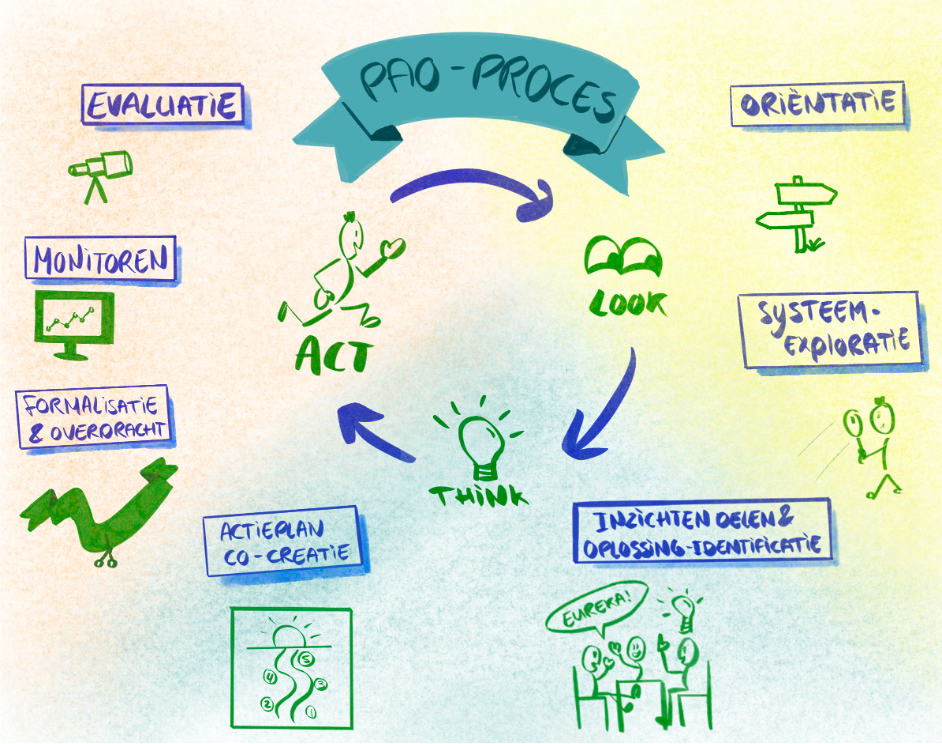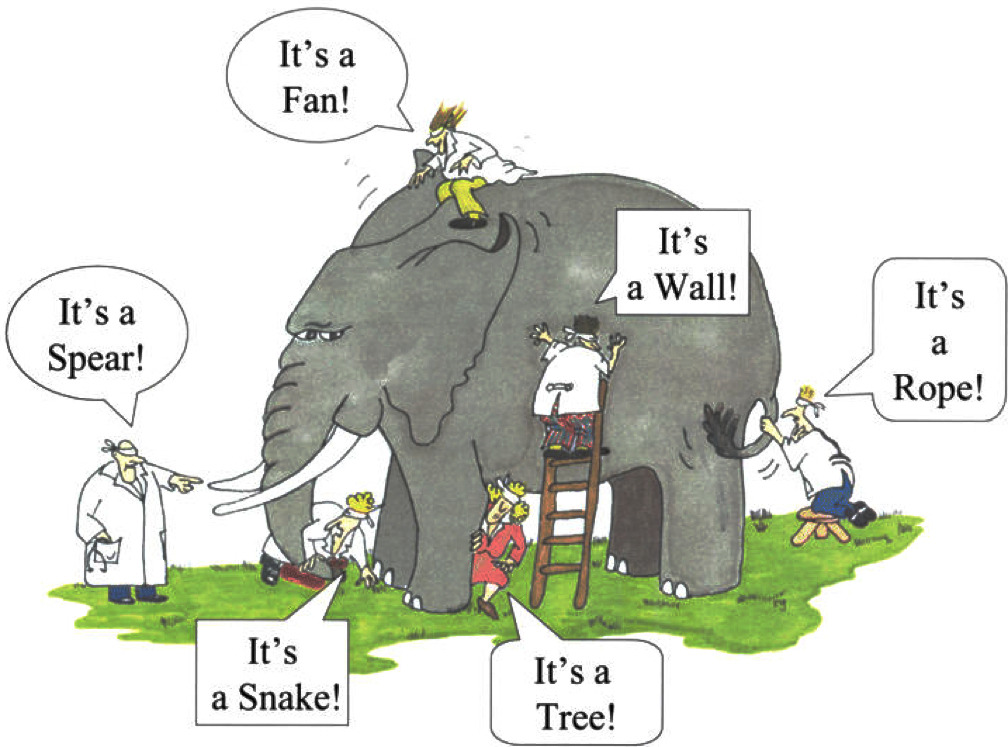Each Participatory Action Research (PAR) looks different, because PAR always adapts to local conditions. However, we can distinguish a number of stages that every PAR goes through (either once or multiple times). Originally it was stated that a PAR goes through several iterative cycles of ‘Look’ (gather information) ‘Think’ (analyze and brainstorm) and ‘Act’ (implement actions to change the situation). SevenSenses founder Madelon Eelderink further developed and concretized these cycles into seven stages in her PhD thesis.
Here we briefly explain these stages to you! Would you like to be taken through these stages in more detail and know which methods to use in which stages? Then order the Handbook Participatory Action Research, written by SevenSenses founder Madelon Eelderink.

Occasion and Orientation
A PAO often finds its origin in a deep-seated desire, problem or challenge of a certain group of people, organization or government (the occasion). As a PAR practitioner you have an initial conversation with one or a few of these actors. On the basis of such an initial conversation, in which this actor describes the current situation/problem definition, desired situation and goal, the PAR practitioner prepares a preliminary PAR design, the first part of the Orientation stage.
Sometimes, if possible, a preliminary PAR design is created together with various stakeholders around the identified topic. Such a PAR design describes the current and desired situation, the purpose of the PAR, the PAR main question and subquestions, the to be involved actors (the PAR community), the PAR methods to be applied and the concepts.
Once a PAR is given the green light, the PAR practitioner goes out into the field to informally learn more about the topic through for example informal interviews with actors, document research and other exploratory methods.
The PAR practitioner introduces him or herself to the community involved in the PAR topic and builds an initial basic relationship with the participants of the PAR. This is also known as ‘Rapport building’.
Based on these initial insights, the PAR practitioner delineates the initial PAR and tweaks the PAR design as needed into a workable PAR design.
Your first Checkpoint is thus reflecting on your PAR design with an initial group of directly involved people and adjusting it in such a way that you are sure that the right issue is being addressed, in order to then – later in the PAR – together with the PAR community, shape the most appropriate solution directions.
Although your workable PAR design is your guide for the rest of your PAR, it always remains adaptable if needed. The information you pick up from the Orientation stage is mostly useful to the PAR practitioner and is usually not suitable for analysis; that’s not a problem, because we have the next stage for that.
System Exploration
Once it is clear what the workable PAR design looks like and there is a view of the PAR activities to be performed, System Exploration can begin.
This stage aims to gain an understanding of the various perspectives of those involved on the the PAR topic or issue and how they relate to each other. The total of perspectives forms ‘the system’: the shared reality of the actors involved (the PAR community).
The metaphor of “the elephant and the blind men” captures this well.

Every stakeholder has their own perspective on the causes and manifestation of a particular problem. In the illustration of ‘the elephant and the blind men’ this is, for example, ‘a fan’, ‘a wall’, ‘a rope’, ‘a tree’, ‘a snake’ or ‘a spear’. In the eyes of each individual actor, they are right.
As a PAR practitioner, you bring all these perspectives together so that the totality of perspectives can be understood, thus creating a new, shared reality – ‘the system’- in which the various problem definitions are embedded. In the case of ‘the elephant and the blind men’, this new shared reality is ‘the elephant’.
System exploration thus consists of examining various aspects and perspectives regarding the PAR topic. For example, we examine the context of the current and desired situation according to the various stakeholders, the ‘gap’ between that current and desired situation and thus the needs of the various stakeholders, their solution directions, their motivation to change the situation (i.e. values) and the assets: everything that is going well, what people are proud of and what is in abundance.
The second Checkpoint of your PAR is shaped by your data analysis. All collected information is analyzed in such a way that the system – ‘the elephant’ – becomes visible.
Insights Sharing & Solution Identification
This stage represents the key tipping point of PAR: the transition from primarily data collection to primarily co-creation and action.
It starts with visualizing your research findings from the System Exploration (and sometimes Orientation), such that it provides a clear picture that can be shared with all those involved in the PAR.
The next step is to share these visualization(s) with the stakeholders. This forms your third Checkpoint: you reflect with stakeholders on the results of the PAR so far and where necessary they make additions and make new connections; this can be seen as a second analysis, this time with stakeholders.
When these results are well visualized, those involved will:
- 1) recognize their own perspective,
- 2) better understand the perspective and resulting behavior of other stakeholders,
- and 3) better understand how various perspectives are are interrelated.
This broadening of one’s own perspective provides space for creativity and new insights to raise the system as a whole to a higher level; in other words, to change the context in which the problem is embedded such that all involved will benefit from it from their perspective.
Seeing this entire system, and how those involved can work together to improve the entire system, creates a cooperative mindset and willingness to work together.
It creates a dynamic that is much more in the nature of collaborative thinking with each other (the dialogue) rather than of outdoing, convincing or contradicting each other (the debate).
This collaborative group dynamic is an important basis for identifying solution directions together with those involved and possibly adding new ideas that come to them at that time.
As a final part of this stage participants prioritize solution directions based on importance, urgency, feasibility, ethical appropriateness or a combination of these.
Actionplan Co-creation
In this stage, PAR participants design concrete action plans on their prioritized solution directions.
As in previous stages, several methods are applicable here, depending on the context of the situation and the form of the prioritized solution directions.
As the fourth Checkpoint of your PAR, the PAR participants check, where necessary with the help of experts, ethical and legal aspects of each prioritized solution directions. Are there groups of actors who might experience negative consequences? Does the solution direction fit within current laws and policies? What should we take into account?
When it appears that the solution direction is ethically and legally justifiable (or that adjustments can be made so that it is the case), the direction of solution can be further developed by those involved into a concrete plan of action.
Based on talents, interests and goals of each stakeholder, they determine who takes on what role and responsibility in the implementation of the action plan.
Formalization & Transferal
Once an action plan is fully crystallized in terms of concrete activities and associated roles and responsibilities, it is important to formalize it in such a way that the sense of ownership gets another boost and participants are reminded of the finality of the PAR in their environment.
Important in this is also celebrating the resulting action plan and other successes – big or small – already achieved. The form of such a celebration is context-dependent.
The conscious experience of such a first success provides extra motivation to continue the action plan and create new success experiences. The PAR practitioner has a very modest role at this stage. In an informal way, often individually, the PAR practitioner reflects briefly with those involved on the roles and responsibilities that have arisen. Does everyone feel comfortable with this and are there needs that have not yet been identified during the focus group sessions (for whatever reason) but should be taken care of?
This constitutes the fifth Checkpoint of the PAR. To keep self-reliance high, also here the PAR practitioner maintains a very modest supportive role. As soon as the first activity in a PAR has started, we speak of implementation. From that moment we enter the next stage.
Monitoring
The PAR practitioner will, where possible, accompany a number of activities for observation, this is called monitoring. This should to the stakeholders not feel like you are ‘checking’ them; if the PAR practitioner suspects that this is felt as such, it is better to refrain from doing so. Again, the PAR practitioner should maintain a modest attitude.
The actual monitoring is done by the stakeholders themselves, who experience their own activities. After having carried out a number of activities for a while, they meet again to reflect on this with the PAR practitioner. This forms the sixth Checkpoint. In the same meeting, if possible, plans can be adjusted and new roles distributed where necessary. Those involved organize as many of these reflection meetings as they deem necessary at this stage.
Evaluation
Evaluation is a stage that occurs – mostly or partly – much later than previous stages. Therefore, it is felt that during evaluation, the PAR has already been long finished. Still, a PAR is not really complete until the evaluation has been performed. This constitutes the seventh (and final) Checkpoint in the PAR.
In a PAR, both the outcomes of the PAR and the process of PAR are evaluated. Involved parties have figured out for themselves at earlier stages what they want to evaluate and how.
Sometimes – where possible – this is done through concrete before and after measurements (where the pre-measurement has already taken place before implementation), but in PAR the perspectives of those involved on what the process and outcomes have done to them are at least as important.
An evaluation in PAR is in principle always a qualitative reflection with those involved on both the process and the outcomes of PAR and what it has brought to them, possibly supplemented by quantitative research. During such an evaluation, scaling up is often discussed.
However, spreading successful initiatives to other settings should always be accompanied by a new – shortened or not – PAR cycle to verify whether and how this initiative fits within the new context.
This should look into the local need for such initiative, local differences in citizen composition, culture, religion, legal differences et cetera.
These are in short the seven stages of PAR as described by SevenSenses founder Madelon Eelderink. If you would like to find out more about the scientific backing of this stage system, read the paper ‘Using participatory action research to operationalize critical systems thinking in social-ecological systems‘.
Thinking about performing one or more PAR cycles in your field of expertise? Don’t hesitate to get yourself trained in PAR. At the SevenSenses Academy we offer different types of training so we’re confident you can find one that suits you!
